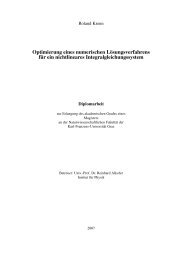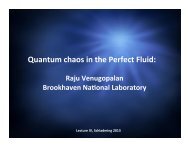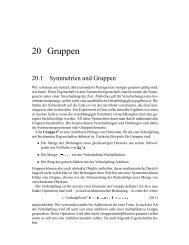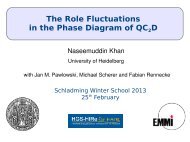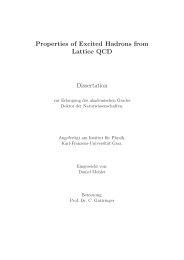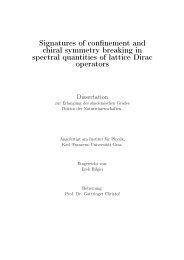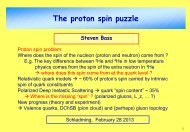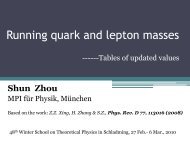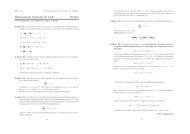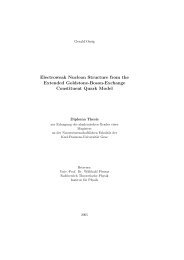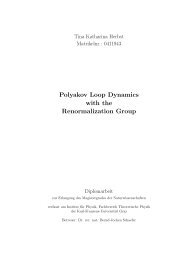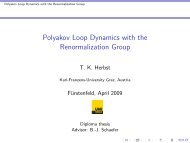The QCD Quark Propagator in Coulomb Gauge and - Institut für Physik
The QCD Quark Propagator in Coulomb Gauge and - Institut für Physik
The QCD Quark Propagator in Coulomb Gauge and - Institut für Physik
Create successful ePaper yourself
Turn your PDF publications into a flip-book with our unique Google optimized e-Paper software.
56 6.1. Introduction<br />
<strong>The</strong> start<strong>in</strong>g po<strong>in</strong>t of the model is Dyson’s equation for the full quark 6-po<strong>in</strong>t function<br />
G, <strong>in</strong> symbolic notation written as<br />
G = G 0 + G 0 KG . (6.1)<br />
Here G 0 is the disconnected three-quark propagator <strong>and</strong> K is the three-quark scatter<strong>in</strong>g<br />
kernel that conta<strong>in</strong>s all two- <strong>and</strong> three-particle irreducible graphs. <strong>The</strong> calculation of the<br />
three-quark wave function can be simplified enormously by two assumptions:<br />
• Neglect three body <strong>in</strong>teractions, i.e. all 3-particle irreducible contributions to the<br />
full 3-quark correlation function.<br />
• Assume that the 2-quark correlation functions can be approximated as a sum over<br />
separable 1 terms that are identified with products of diquark-quark vertex functions.<br />
We detail on the second po<strong>in</strong>t <strong>in</strong> section 6.2. Reference [BCP89] reported a rudimentary<br />
study of this Faddeev equation <strong>and</strong> subsequently more sophisticated analyses have<br />
appeared. As already mentioned our approach is based on the one which was taken <strong>in</strong><br />
reference [Oet00].<br />
As po<strong>in</strong>ted out <strong>in</strong> chapter 5 diquarks do not survive as asymptotic states, the attraction<br />
between quarks <strong>in</strong> this channel grounds a picture of baryons <strong>in</strong> which two quarks are always<br />
correlated as a colour-¯3 diquark pseudoparticle, <strong>and</strong> b<strong>in</strong>d<strong>in</strong>g is effected by the iterated<br />
exchange of roles between the byst<strong>and</strong>er <strong>and</strong> diquark-participant quarks.<br />
It has become apparent that the dom<strong>in</strong>ant correlations for ground state octet <strong>and</strong><br />
decuplet baryons are scalar <strong>and</strong> axial-vector diquarks, primarily because the associated<br />
mass-scales are smaller than the masses of these baryons [Mar02] <strong>and</strong> the positive parity<br />
of the correlations matches that of the baryons. Both scalar <strong>and</strong> axial-vector diquarks<br />
provide attraction <strong>in</strong> the Faddeev equation; e.g., a scalar diquark alone provides for a<br />
bound octet baryon <strong>and</strong> <strong>in</strong>clud<strong>in</strong>g axial-vector correlations reduces that baryon’s mass.<br />
With the retention of axial-vector diquark correlations a quantitative description of<br />
baryon properties is atta<strong>in</strong>able [OHAR98]. However, that possibility necessitates the <strong>in</strong>corporation<br />
of pseudoscalar meson loop contributions because a credible description of<br />
baryon properties is otherwise problematic. Such effects contribute materially: to baryon<br />
masses [H + 02, Tho84, YLTW01]; <strong>and</strong> charge <strong>and</strong> magnetic radii, <strong>and</strong> magnetic moments<br />
[HJLT00a, HJLT00b, LTY01].<br />
In the follow<strong>in</strong>g section we discuss the approximation for the two-quark correlation<br />
matrix. In 6.3 we <strong>in</strong>troduce those aspects of the Po<strong>in</strong>caré covariant Faddeev equations<br />
1 Separability means that the two-quark correlation matrix is not supposed to conta<strong>in</strong> products between<br />
the “<strong>in</strong>go<strong>in</strong>g” <strong>and</strong> “outgo<strong>in</strong>g” momenta.



